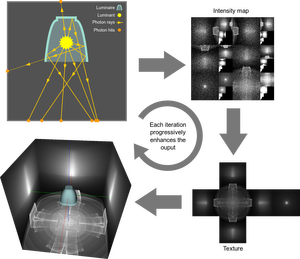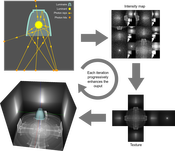Information
- Publication Type: Master Thesis
- Workgroup(s)/Project(s):
- Date: March 2016
- TU Wien Library:
- First Supervisor:
- Keywords: photon tracing, luminaire design, lighting design
Abstract
Modern workflows in architectural planning and lighting design require physically reliable lighting simulations for detailed and complex 3D models. Current workflows for luminaire design and lighting design are not tailored to each other. During luminaire design, CAD programs are used to create 3D models of luminaires, and offline rendering tools are used to visualize the light distribution. In lighting design, light concepts are explored by placing light sources - previously created during luminaire design - in a 3D scene using an interactive light-planning software, but it is not possible to modify the light sources themselves. This thesis presents an interactive global-illumination algorithm to simulate the light distribution of a luminaire. The algorithm produces visually pleasing intermediate results at interactive frame rates, before converging to a physically plausible solution that can be imported as a representation of a light source into a light-planning software. We combine an interactive, progressive photon-tracing algorithm with a multi-resolution image-filtering approach. Our algorithm iteratively emits photons into a 3D scene containing the model of a luminaire and progressively refines results. We use mipmaps to create a multi-resolution approach and incorporate image-filtering techniques to obtain visually pleasing intermediate results. Evaluations based on objective quality metrics show that the presented image-filtering approach increases image quality when compared to non-filtered results. The proposed algorithm provides fast previews and allows interactive modifications of the geometry and material properties of the luminaire in real time. This reduces time between modification iterations and therefore turns luminaire design into an interactive process that reduces overall production time.Furthermore, the presented approach integrates luminaire design into lighting design and therefore provides a new way to combine two former decoupled workflows.Additional Files and Images
Weblinks
No further information available.BibTeX
@mastersthesis{Kroesl_Katharina_2016_PPT,
title = "Interactive, Progressive Photon Tracing using a
Multi-Resolution Image-Filtering Approach",
author = "Katharina Kr\"{o}sl",
year = "2016",
abstract = "Modern workflows in architectural planning and lighting
design require physically reliable lighting simulations for
detailed and complex 3D models. Current workflows for
luminaire design and lighting design are not tailored to
each other. During luminaire design, CAD programs are used
to create 3D models of luminaires, and offline rendering
tools are used to visualize the light distribution. In
lighting design, light concepts are explored by placing
light sources - previously created during luminaire design -
in a 3D scene using an interactive light-planning software,
but it is not possible to modify the light sources
themselves. This thesis presents an interactive
global-illumination algorithm to simulate the light
distribution of a luminaire. The algorithm produces visually
pleasing intermediate results at interactive frame rates,
before converging to a physically plausible solution that
can be imported as a representation of a light source into a
light-planning software. We combine an interactive,
progressive photon-tracing algorithm with a multi-resolution
image-filtering approach. Our algorithm iteratively emits
photons into a 3D scene containing the model of a luminaire
and progressively refines results. We use mipmaps to create
a multi-resolution approach and incorporate image-filtering
techniques to obtain visually pleasing intermediate results.
Evaluations based on objective quality metrics show that the
presented image-filtering approach increases image quality
when compared to non-filtered results. The proposed
algorithm provides fast previews and allows interactive
modifications of the geometry and material properties of the
luminaire in real time. This reduces time between
modification iterations and therefore turns luminaire design
into an interactive process that reduces overall production
time.Furthermore, the presented approach integrates
luminaire design into lighting design and therefore provides
a new way to combine two former decoupled workflows.",
month = mar,
address = "Favoritenstrasse 9-11/E193-02, A-1040 Vienna, Austria",
school = "Institute of Computer Graphics and Algorithms, Vienna
University of Technology ",
keywords = "photon tracing, luminaire design, lighting design",
URL = "https://www.cg.tuwien.ac.at/research/publications/2016/Kroesl_Katharina_2016_PPT/",
}


